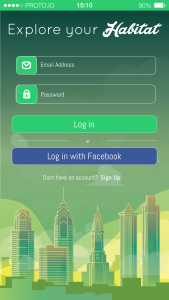Interning at a startup: Habitat Local Marketplace
Thanks to help from the IEI, I was able to have the experience of interning full-time with a mobile app startup company, Habitat. They are focusing on building a safe and user friendly platform for peer to peer exchanges around college campuses. For the entrepreneurially minded, an intuitive and locally based platform to post goods and services for sale…haircuts, rideshares, bike repairs, guitar lessons, and apparel. For everyone else, a simple solution for buying cheap books, housing, or crowdfund an open bar night in the surrounding area. Habitat’s founder Andrew Nakkache is a Temple student working through West Philly tech incubator crowdCampuses/coPhilly.
In August, I joined to core development team of Habitat, consisting of students and graduates from UPenn, Drexel, and Temple. In the first few weeks, the majority of the time was spent deciding on a development platform and forming master requirement documentation. For the platform, we ended up deciding on building a web app with a framework called Meteor.js (which I talk about in this blog post). For requirements, we took market validation data and compared it to our use cases/user stories in an attempt to weed out features that might be unnecessary for a beta release. Specifically, I was heavily involved in evaluating 3rd party APIs for food ordering, payment processing, and group purchasing (among others). After we had nailed down a vision for the product, we laid out each user story into a SCRUM…
 Scrums aren’t just for rugby, but also a term referring to the agile development practice of building software in small, cross-functional teams to foster rapid development. Our team assigned each user story to a developer, a priority-level, and to one of six ten-day “sprints”. During these sprints, every two days we meet for an hour. In round-robin fashion, we each discuss our experiences since last meeting:
Scrums aren’t just for rugby, but also a term referring to the agile development practice of building software in small, cross-functional teams to foster rapid development. Our team assigned each user story to a developer, a priority-level, and to one of six ten-day “sprints”. During these sprints, every two days we meet for an hour. In round-robin fashion, we each discuss our experiences since last meeting:
- What have you gotten done in the last two days?
- Were there any obstacles that the rest of the team could help to solve?
- What do you plan on doing in the next two days?
So, with a clear product vision and our processes figured out, we jumped into sprint 1.
Because I had only been working in Javascript for about a year, the learning curve was steep starting out. Luckily, Meteor made that transition as painless as possible, because both the server and client code are written in Javascript. Once I became more familiar with the framework, my time spent coding became much more productive. I was able to design a full login and authentication system, a working shopping cart, and a mobile geolocation tool to help users find each other. I also played a role in configuring our cloud based servers: migrating the projects, setting up a Git repository, implementing a private drive for documentation, and working with the website.
With about two months to go until beta, we are in the process of integrating the code from the first four sprints into a working mobile app to begin testing and refactoring. I’ve had an amazing experience so far working in a startup environment and will continue to work with Habitat in the future. The value of working on this project has given me an enormous amount of real-world hands on experience which directly relate to my Entrepreneurship and MIS majors.

